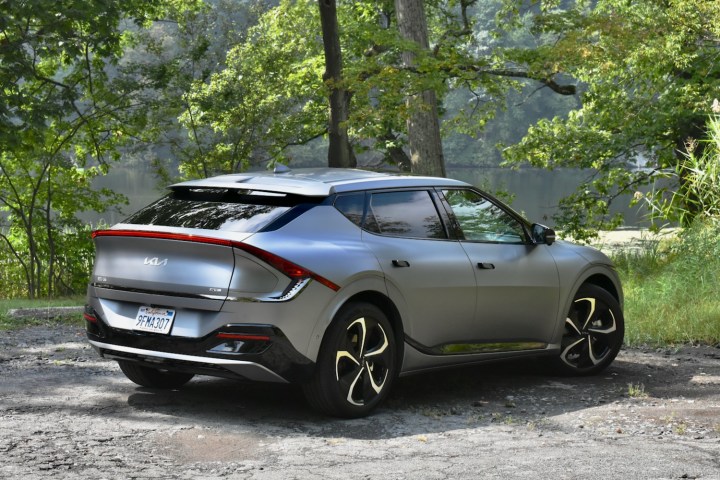“Sporty, unique, and innovative, Kia's first purpose-built EV shows the rest of the industry how it's done.”
- Distinctive design
- Great to drive
- Impressive standard infotainment system
- Up-to-date charging hardware
- Not the best value
Kia doesn’t have an illustrious heritage to look back on like some other automakers, but that also means it’s less encumbered by tradition. And that makes designing a new EV from the ground up a lot easier.
Launched for the 2022 model year, the Kia EV6 is the brand’s first clean-sheet EV design. While Kia previously marketed electric versions of the Soul and Niro, the EV6 is the first production EV from the brand with no ties to internal combustion. It does, however, have ties to the Hyundai Ioniq 5 and Ioniq 6 from Kia’s corporate parent, as well as the Genesis GV60, as it shares those models’ E-GMP platform.
Kia has a reputation for value, but the EV6 starts higher than its Hyundai platform-mates, at $50,025 for the EV6 Wind, which serves as the base model in most regions (a $43,925 EV6 Light model is available in limited areas). Like other E-GMP models, pricing also climbs quickly for high-end models, with the top EV6 GT starting at $62,925. Our test car was an EV6 GT-Line, with a $58,925 base price that puts it just below the GT in the lineup.
Design and interior

Like the Hyundai Ioniq 5 and Genesis GV60, the EV6 is marketed as a crossover SUV. But it has a very different look from any other crossover — electric or otherwise.
Kia settled on an interesting mix of automotive styling elements for the EV6. Its width and elevated ride height are SUV-like, but the long and low roof seems more appropriate for a station wagon. Short overhangs — particularly at the front — are a visual reminder that Kia didn’t have to package up an engine. The result is something that is neither entirely car or SUV. Put another way, the EV6 would look just as good with slammed suspension and a body kit as it would with a roof rack and chunky tires.
The different shape doesn’t have a dramatic impact on passenger space. Headroom and legroom in both rows are about the same as in the Ioniq 5. However, the EV6’s 24.4 cubic feet of cargo space (50.2 cubic feet with the rear seats folded) trails the Hyundai. That’s also well behind the manufacturer-quoted cargo space for the Tesla Model Y. The Tesla also has a 4.1-cubic-foot frunk, while the Kia has an afterthought bin. But headroom and legroom is fairly close between the two. It’s also worth noting that you have to step down to get into the EV6 — not a very SUV-like trait.
The EV6 has a very different look from any other crossover — electric or otherwise.
Like many current EVs, the EV6 has a minimalist interior, but Kia charts its own path with some interesting details. The curved touchscreen sits in a bowled dashboard, so it doesn’t just look tacked on. The door handles sit in sleek triangular enclosures. Instead of the open space of the Hyundai Ioniq 6 and Ioniq 5, Kia designers chose a high center console. That creates a more enclosed feel, but it’s the perfect spot for the start button and dial-like shifter, while still leaving some useful storage space below.
However, while our EV6 GT-Line test car sported cool textile-like trim on the dashboard and white trim on the seats, we could do without the glare-inducing piano black plastic. And while Kia may brand the upholstery as “vegan leather” in a nod toward sustainability, it’s the same synthetic leather typically used by automakers as a cost-saving measure.
Tech, infotainment, and driver assist

Kia doesn’t shortchange customers on screens. A 12.3-inch digital instrument cluster and 12.3-inch touchscreen, squished together to look like one continuous screen, come standard on all models. Built-in navigation is standard as well, but that also means only wired Apple CarPlay and Android Auto are available. Kia and Hyundai currently offer wireless versions only on smaller screens without navigation, although that will change with a new infotainment system rolling out in updated models, starting with the 2024 Hyundai Kona.
The rearview camera images are so clear and sharp that you could shoot an Instagram Reel with them.
For now, the dual-screen setup in the EV6 has a lot going for it. The screens are perfectly positioned for quick viewing without blocking the driver’s field of position and, to our eyes at least, the resolution is among the best in the business. The rearview camera images are so clear and sharp that you could shoot an Instagram Reel with them. The same goes for the available blind-spot view cameras, which, as in other Kia, Hyundai, and Genesis products, shows a camera view in the instrument cluster when you flick a turn signal.
Like the Kia Sportage, the EV6’s dual 12.3-inch screens are backed up to a touch control panel that sits below the central touchscreen. It includes two analog knobs for audio volume and tuning, but everything else is touch, allowing the panel to switch between audio and climate control functions rather than having hard buttons for both.
The standard front USB-C and USB-A ports (one of each is included) and 12-volt outlet are placed on the floor near the firewall, so your phone will be inaccessible if you use them. However, the EV6 also has standard wireless phone charging, in a conveniently placed slot. Two USB-C ports for second-row passengers — mounted on the backs of the front seats — are also standard.
The EV6 gets the same Drive Wise driver-assist tech as other Kia models: blind spot monitoring, rear cross-traffic alert, a driver attention monitor, lane-keep assist, adaptive cruise control, and Highway Driving Assist. A machine-learning function for the adaptive cruise control, as well as a Highway Driving Assist 2 system that adds automated lane changes, are standard on higher trim levels, along with Remote Smart Parking Assist automated parking.
Driving experience

Most EV6 models get the same 77-4.kilowatt-hour battery pack. Kia does offer the EV6 Light with a 58-kWh pack (and a lower base price), but for 2023, availability has been restricted to a handful of western states.
That means, for most buyers, the entry-level model will be the 77.4-kWh EV6 Wind, which is rated at 225 horsepower and 258 pound-feet of torque with its standard single-motor rear-wheel drive powertrain, or 320 hp and 446 lb-ft of torque with the optional dual-motor all-wheel drive powertrain. Kia estimates zero to 60 mph in 7.2 seconds with rear-wheel drive and 5.1 seconds with all-wheel drive.
When it comes to ride and handling, the EV6 really is the best of both worlds.
Those specs carry over to GT-Line models like our dual-motor test car. And the brisk acceleration afforded by that dual-motor powertrain wasn’t the only sporty thing about it. The Kia felt much more at home in corners than its Hyundai Ioniq 5 platform mate, staying planted despite its elevated ride height. The steering also felt more precise, and the EV6 had a general willingness to turn into corners that the more laid-back Hyundai lacked. The Kia also had a comparably comfortable ride, feeling very smooth over rough pavement. So it really is the best of both worlds.
The GT-Line isn’t even the true performance model of the lineup. The Kia EV6 GT gets a high-output version of the dual-motor powertrain that’s good for 576 hp and 545 lb-ft of torque, making it by far the most powerful production Kia ever. The manufacturer-estimated zero to 60 mph time of 3.4 seconds also beats the Ford Mustang Mach-E GT Performance Edition and Tesla Model Y Performance — two sporty variants of similarly sized EV crossovers — by 0.1 second.
Electric range, charging, and safety

The EV6 gets the most range in rear-wheel drive form, at 310 miles. All-wheel drive range is dependent on trim level, with the Wind rated at 282 miles and the GT-Line and GT at 252 miles and 206 miles, respectively. The small-battery EV6 Light is rated at 232 miles, and is only available with rear-wheel drive.
One of the biggest advantages of the Hyundai E-GMP platform is an 800-volt electrical architecture that allows for quicker charging. The EV6 can DC fast charge at up to 350 kilowatts, which can get the battery to 80% capacity in 18 minutes, if you can find a powerful enough fast-charging station. A 10.9-kW AC charger can fully recharge the battery in seven hours and 10 minutes. A standard Vehicle-to-Load (V2L) port also lets the EV6 send power back to your home in the event of a power outage.
The EV6 was named a 2022 Insurance Institute for Highway Safety (IIHS) Top Safety Pick+, the organization’s highest safety award, which applies to 2022 and 2023 models. It also got a five-star overall safety rating from the National Highway Traffic Safety Administration (NHTSA).
Like gasoline Kia models, the EV6 also gets an impressive warranty. Kia’s 10-year, 100,000-mile powertrain warranty includes the battery. Tesla offers more mileage (120,000 miles), but a shorter coverage period (eight years) for the Model Y battery.
How DT would configure this car

As impressed as we were with our GT-Line test car, it’s possible to get nearly all of the same features in the cheaper Wind model by checking a few option boxes. With a base price about $8,000 less than the GT-Line, the Wind gets the same dual-screen infotainment setup, while the clever blind-spot camera system and most of the other driver aids that are standard on the GT-Line are available as options. The Wind is also the only EV6 model to surpass 300 miles of range.
The 576-hp EV6 GT has impressive specs, but doesn’t offer any tech features distinct from the Wind and GT-Line models. As noted above, the standard version of the EV6’s dual-motor powertrain still delivers quick acceleration, and the EV6 GT takes a big range hit for its sports car-rivaling performance.
While it shares the E-GMP platform with the Hyundai Ioniq 5 and Genesis GV60, the Kia stakes out a unique position with sportier driving dynamics and a more forward-looking design than the Hyundai, and less bling than the Genesis. But if you don’t need a ton of cargo space, the Hyundai Ioniq 6 sedan is pleasant to drive, looks distinctive, and has a lower base price than the Kia.
Looking outside the E-GMP family, the Tesla Model Y offers 330 miles of range for about the same price, although the instability of both Tesla pricing and the company’s CEO need to be factored in. The Ford Mustang Mach-E is similarly sporty, and its available BlueCruise driver-assist system is more sophisticated than anything Kia offers. The Nissan Ariya has a well-designed interior and feels more like a true SUV, although it’s much less engaging to drive than the EV6. Overall, though, it’s hard to find fault with the EV6. It’s a great EV, but also just a great car.




